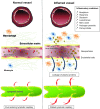Nanomedicine for drug targeting: strategies beyond the enhanced permeability and retention effect
- PMID: 24904213
- PMCID: PMC4039421
- DOI: 10.2147/IJN.S47129
Nanomedicine for drug targeting: strategies beyond the enhanced permeability and retention effect
Abstract
The growing research interest in nanomedicine for the treatment of cancer and inflammatory-related pathologies is yielding encouraging results. Unfortunately, enthusiasm is tempered by the limited specificity of the enhanced permeability and retention effect. Factors such as lack of cellular specificity, low vascular density, and early release of active agents prior to reaching their target contribute to the limitations of the enhanced permeability and retention effect. However, improved nanomedicine designs are creating opportunities to overcome these problems. In this review, we present examples of the advances made in this field and endeavor to highlight the potential of these emerging technologies to improve targeting of nanomedicine to specific pathological cells and tissues.
Keywords: cancer treatment; inflammation; nanomedicine; permeability and retention effect; tissue targeting.
Figures




Similar articles
-
The EPR effect and beyond: Strategies to improve tumor targeting and cancer nanomedicine treatment efficacy.Theranostics. 2020 Jun 25;10(17):7921-7924. doi: 10.7150/thno.49577. eCollection 2020. Theranostics. 2020. PMID: 32685029 Free PMC article.
-
Leukocyte-mediated Delivery of Nanotherapeutics in Inflammatory and Tumor Sites.Theranostics. 2017 Jan 25;7(3):751-763. doi: 10.7150/thno.18069. eCollection 2017. Theranostics. 2017. PMID: 28255364 Free PMC article. Review.
-
Anticancer nanomedicine and tumor vascular permeability; Where is the missing link?J Control Release. 2012 Dec 28;164(3):265-75. doi: 10.1016/j.jconrel.2012.07.013. Epub 2012 Jul 16. J Control Release. 2012. PMID: 22800576 Review.
-
Exploiting passive nanomedicine accumulation at sites of enhanced vascular permeability for non-cancerous applications.J Control Release. 2017 Sep 10;261:10-22. doi: 10.1016/j.jconrel.2017.06.013. Epub 2017 Jun 16. J Control Release. 2017. PMID: 28625673 Review.
-
The role of nanotechnology in gastrointestinal cancer.J Biomed Nanotechnol. 2014 Nov;10(11):3204-18. doi: 10.1166/jbn.2014.1816. J Biomed Nanotechnol. 2014. PMID: 26000381 Review.
Cited by
-
Understanding the in vivo Fate of Advanced Materials by Imaging.Adv Funct Mater. 2020 Sep 10;30(37):1910369. doi: 10.1002/adfm.201910369. Epub 2020 Apr 6. Adv Funct Mater. 2020. PMID: 38545084 Free PMC article.
-
Emulsion Technology in Nuclear Medicine: Targeted Radionuclide Therapies, Radiosensitizers, and Imaging Agents.Int J Nanomedicine. 2023 Aug 3;18:4449-4470. doi: 10.2147/IJN.S416737. eCollection 2023. Int J Nanomedicine. 2023. PMID: 37555189 Free PMC article. Review.
-
The Evolution and Recent Trends in Acoustic Targeting of Encapsulated Drugs to Solid Tumors: Strategies beyond Sonoporation.Pharmaceutics. 2023 Jun 10;15(6):1705. doi: 10.3390/pharmaceutics15061705. Pharmaceutics. 2023. PMID: 37376152 Free PMC article. Review.
-
Peripheralization Strategies Applied to Morphinans and Implications for Improved Treatment of Pain.Molecules. 2023 Jun 14;28(12):4761. doi: 10.3390/molecules28124761. Molecules. 2023. PMID: 37375318 Free PMC article. Review.
-
Nanomedicine strategies to improve therapeutic agents for the prevention and treatment of preterm birth and future directions.Nanoscale Adv. 2023 Mar 4;5(7):1870-1889. doi: 10.1039/d2na00834c. eCollection 2023 Mar 28. Nanoscale Adv. 2023. PMID: 36998665 Free PMC article. Review.
References
-
- Matsumura Y, Maeda H. A new concept for macromolecular therapeutics in cancer chemotherapy: mechanism of tumoritropic accumulation of proteins and the antitumor agent smancs. Cancer Res. 1986;46(12 Pt 1):6387–6392. - PubMed
-
- Iwai K, Maeda H, Konno T. Use of oily contrast medium for selective drug targeting to tumor: enhanced therapeutic effect and X-ray image. Cancer Res. 1984;44(5):2115–2121. - PubMed
-
- Konno T, Maeda H, Iwai K, et al. Selective targeting of anti-cancer drug and simultaneous image enhancement in solid tumors by arterially administered lipid contrast medium. Cancer. 1984;54(11):2367–2374. - PubMed
-
- Leu AJ, Berk DA, Lymboussaki A, Alitalo K, Jain RK. Absence of functional lymphatics within a murine sarcoma: a molecular and functional evaluation. Cancer Res. 2000;60(16):4324–4327. - PubMed
Publication types
MeSH terms
Substances
LinkOut - more resources
Full Text Sources
Other Literature Sources

